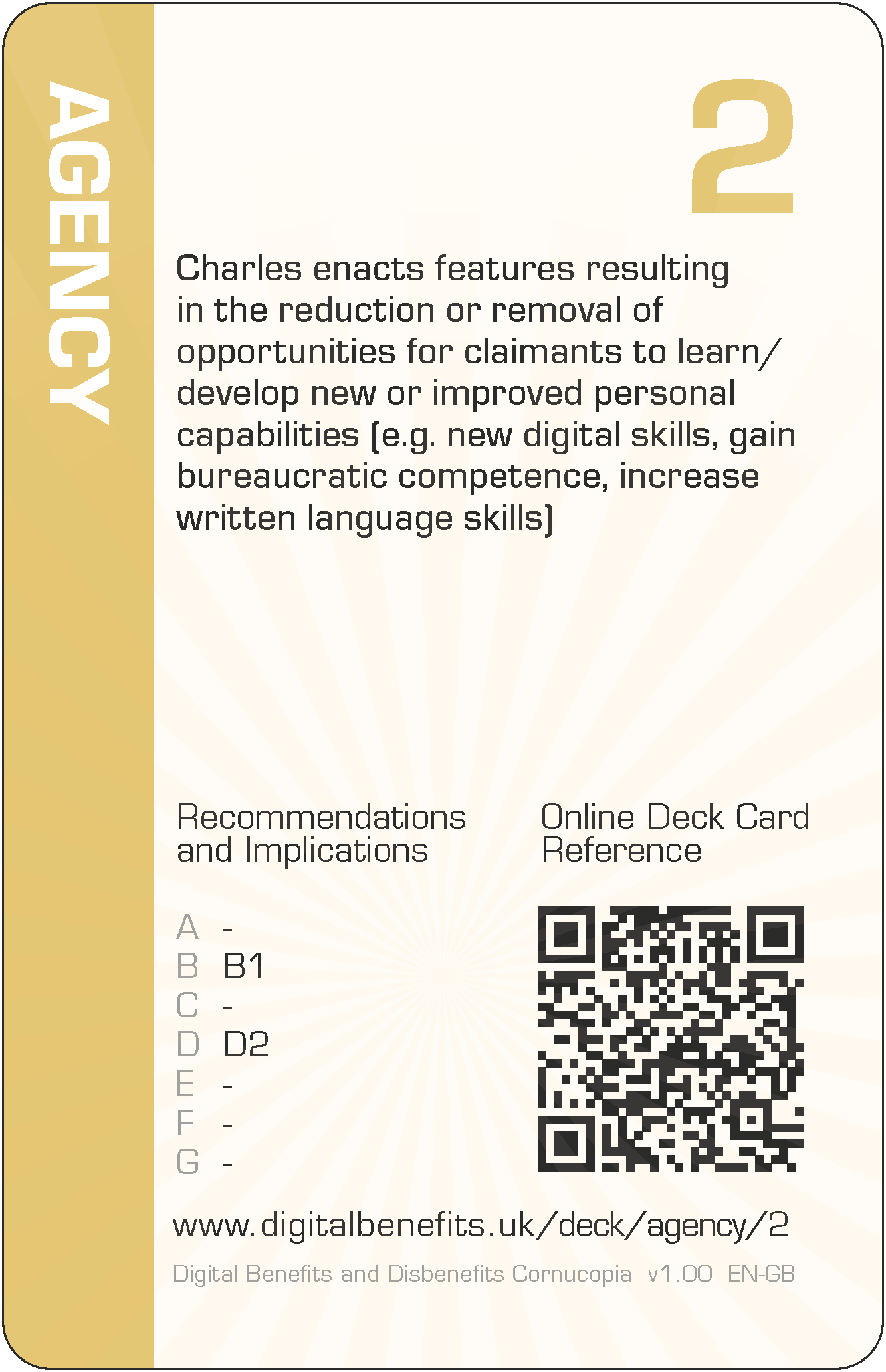Agency 2 (AG-2) Card
DBD Cornucopia > Deck > Agency > 2
Card Details - Two of Agency
Abbreviation
AG-2
Card's focus
The focus of this card is claimants' personal capabilities
Threat to claimants
Charles enacts features resulting in the reduction or removal of opportunities for claimants to learn/develop new or improved personal capabilities (e.g. new digital skills, gain bureaucratic competence, increase written language skills)

Threat to claimants
Charles enacts features resulting in the reduction or removal of opportunities for claimants to learn/develop new or improved personal capabilities (e.g. new digital skills, gain bureaucratic competence, increase written language skills).
Some examples of how this threat could lead to harms (negative effects on claimants)
The design recommendations and implications relevant to the card are listed below in the next section, but even those can be somewhat abstract and difficult to think about during practical day-to-day implementation. Therefore, some example harms are provided to complement the more formal research outputs. These examples are unique per card, and are only published on these web pages (i.e. in no other project outputs).
- Claimants do not gain proficiency in dealing with the government, which affects them adversely at a later date
- Crude automated translations fully replace the original text (thus not seen by claimants), which loses important information and reduces their learning of English or Welsh
- Simplifications abstract claimants from the real complexities of welfare benefit claims, so claimants never get to grip with the relevant rules and conditions, limiting their understanding, missing out on beneficial adjustments and being sanctioned more frequently
The examples are to help understand the threat on the card, not to suppress thinking and innovation. Incorporating these examples exactly, or closely matching ones, should be scored down when playing DBD Cornucopia as a game.
Applicable design recommendations and implications
These are reproduced here from Research Briefing N
Acknowledge claimants as people in digital design
- Prioritise claimants' interests over system efficiencies
All digital welfare design processes, methods and decision-making should prioritise claimants' needs to achieve best outcomes for individuals rather than system efficiencies. Organisational knowledge and resources should be utilised to this respect including intervening in advance to identify matters that affect claims or what claimants may have forgotten about.
Embrace a wider ecosystem and fuller claimant activity viewpoint for digitised public services
- Design for the needs of claimants’ lives covering their expansive activities
Recognise that service take-up requires more than direct interactions with the state. Ensure design is not restricted to service delivery between interaction points of claimants and the state within a 'user journey', and instead span all actors and mediating instruments that come together to achieve the claimant's goal.
General Notes
Card values (i.e. '2' for this card) are for game play and are not correlated with the severity of harm. This is because threats cannot be ranked directly since they can affect individuals in different ways due to situations and circumstances, or affect fewer or more claimants, or the harms can arise in claimants' support networks and wider society.
The threat description uses a person's name as the "attacker" (i.e. 'Charles' for this card), which can be thought of someone involved with implementation. They could have any role which influence digitisation. So they could be a database administrator, or a copy writer, or a quality assurance specialist, etc, or all of these. Everyone could have some influence on the claimant threat described. The names were randomly selected from those currently most popular as given names for boys and girls (UK Office for National Statistics).
The example harms provided are drawn from the research data (which explored not only parts of existing services but also the effects of possible changes to those), from the author's own knowledge of web application development and testing, the author's own experience of helping citizens to claim Universal Credit (UC) and Personal Independence Payment (PIP), and from suggestions submitted by other people (make a suggestion). The threats and example harms do not necessarily exist in the current UC or PIP deployments or in ecosystems around those services, but they might well do.
All the cards in this Agency suit are: 2 3 4 5 6 7 8 9 10 J Q K A
The other suits in the deck are: Scope, Architecture, Trust, Porosity and Cornucopia (plus Jokers).
